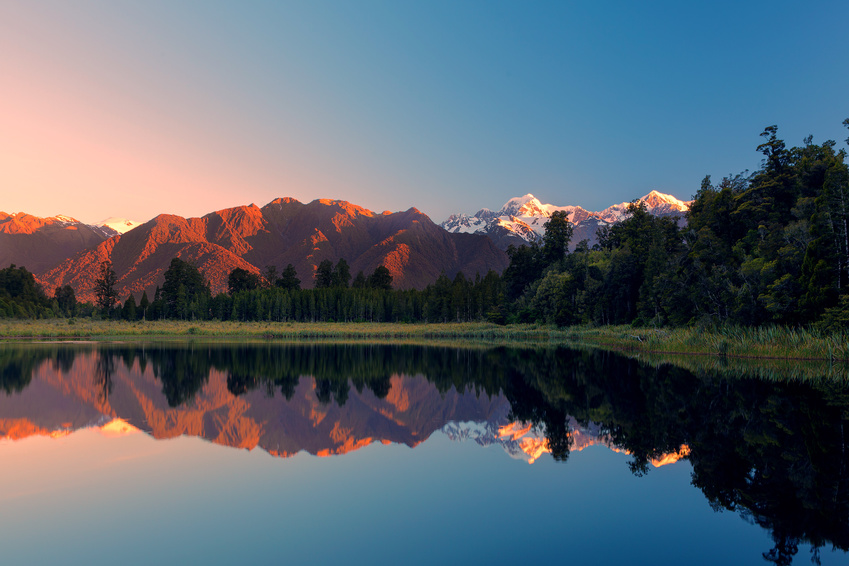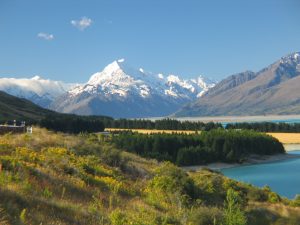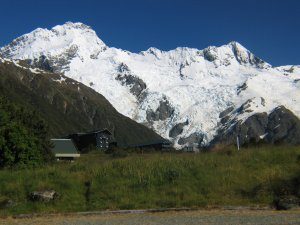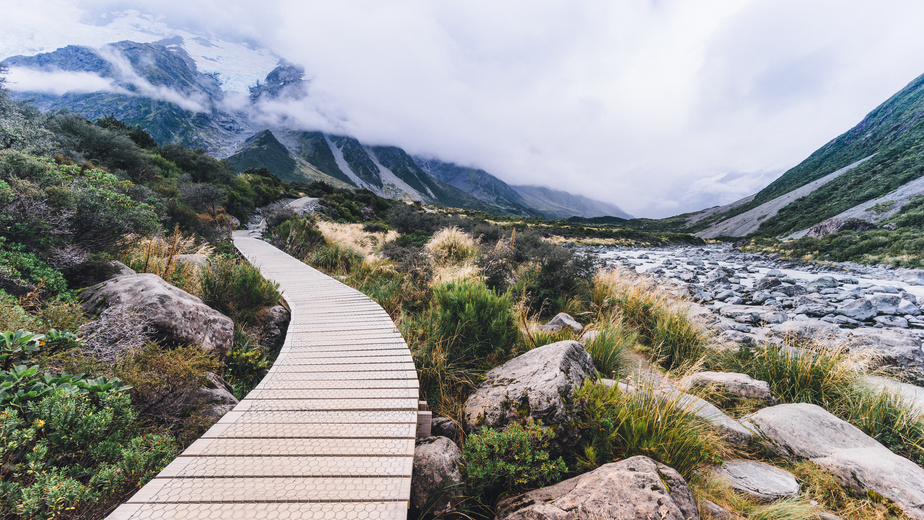Mt Cook is by far one of the most impressive highlights of the South Island and New Zealand in general. A prominent peak with its jagged edges, angry looking glaciers and height, it towers above the nearby mountains. The beauty of this area is that you can experience to a small extent, what the Himalayas look like from only an elevation of about 500 meters. On clear days the panoramic vistas are absolutely stunning.
Note that Mt. Cook is only about 30 miles from the ocean – so this area is a recipient of numerous storms and or cloudy days throughout the year.
As one drives towards Mt. Cook one will pass pass by the beautiful glacial colored Lake Pukaki. At one point along Highway 80, visitors will reach a lookout above the lake with Mt. Cook framing one end of the lake in the background. Simply pull into the large gravel pullout, lean out of the car and take a photo or even get out of the car for a few minutes to enjoy the quiet and the scenery. However, we recommend getting out of the car and hiking down the backside of this viewpoint onto a little used trail that leads down to the shores of Lake Pukaki.
The shore of this lake on a clear day is a great place to take pictures – Mt. Cook shows clearly in the background and the color of the lake is a diverse mix of blues and greens. Want to get wet? Why not? If you are up for an invigorating swim take a quick dip in the very cold waters. When the sun is shining on a summer day, lay right on the small pebbles next to the water’s edge and soak in the warmth.
Continue driving down Highway 80 towards Mt. Cook passing through beautiful scenery. Eventually you will arrive at Mt. Cook Village – the primary lodging/gathering point for the park. Its situated on the west side of the Hooker Valley and as a consequence is in shadows earlier in the evening compared to the other side of the valley. Regarding cooking your own food, one should definitely stock up on veggies and other food items before coming to the Mt. Cook Village, as prices are high and you really won’t find much in the way of items to purchase for cooking.
However Mt. Cook Village offers several lodging options: The Hermitage is by far its most famous and luxurious hotel. It dates back to 1884 but has been destroyed several times since its original construction due to flooding and fires. Even if you are not staying here, check out the gift shop, bar, or buy a snack upstairs and chill out on the deck with the excellent views of Mt. Cook. The Hermitage offers two dining options; Alpine Restaurant and Panorama Room – both are not cheap, but serve quality food. The Panorama Room is appropriately named.
Other lodging options include the much cheaper Mt. Cook YHA – this is a very good hostel – and like many of New Zealand’s most popular hostels, this one needs to be reserved well in advance as it is in very high demand during the summer season.
About 1/2 km from the hostel and located towards the center of the village is the shared “cooking hut” – this is a well constructed V style building in which one can cook – there is one electrical outlet that is used often to connect to a water boiler – and there are several tables inside the building. Its hard to find free electrical outlets in the village if you are not staying in one of the hotels – so when this one is not being used for cooking purposes its good for plugging in a phone or any other electrical item you may need to recharge.
The back of the building contains 24/7 free showers and bathrooms. However, note that the showers are only free if you use the cold water. If you want hot water you have to pay a small amount. Also note that the water from the shower is quite cold and will really wake you up if you lack the money to pay for a warm shower! We overheard one lady screaming at the top of her lungs as she exited the shower while simultaneously yelling out numerous obscenities. Those in the actual hut rushed out the back door wondering if someone was being hurt or otherwise needed help. We are so glad there were no tiny children nearby when she was taking her shower.
Sir Edmund Hilary is iconic in New Zealand, but especially so in the Mt. Cook region. He and a party of climbers climbed Mt. Cook successfully in 1948. A bronze statue of him with his ice ax is located in front of the Hermitage. Sir Edmund is on all the Five Dollar New Zealand paper bills. In the summer, climbers, guides or other adventurous travelers give scheduled talks and slide shows in the village. Sir Edmund was scheduled to give a talk 3 weeks after the author was here.
We highly recommend eating at the cozy Old Mountaineers Cafe Bar & Restaurant located below the Hermitage. This was dedicated and opened by Sir Edmund Hilary with a plaque in front of the restaurant detailing some of his accomplishments. The exterior of the restaurant is made of pine – the interior is quite casual and features a relaxed atmosphere. A side room contains a pool table. Pay a small fee for a game of pool. This restaurant is one of the hubs in the village for meeting fellow climbers, hikers, travelers etc. At night, many locals who live or work in the village hang out over a glass of wine or a beer. The food here is excellent – a little pricey but well worth the extra change.
Hiking
There are some excellent hiking trails in the area. One note about hiking is if its in the summer and the sun is out, be sure to wear strong suntan lotion. Its very easy to get burnt in the strong sunlight.
One particular hike begins from Hooker Valley Road – which is the main valley located near the Mt. Cook Village area. Hooker Valley Road leads off of Highway 80 about 1/2 km outside of the village. Its a dirt road that leads to a parking lot/campground. The campground here is called the White Horse Hill Camping area – this is a basic camp ground, one of the cheapest you will find in New Zealand – only a couple of dollars per person per night. Running water and toilets are provided, but no showers – you would have to use the showers in the back of the shared cooking hut back in the Mt. Cook Village.
Day use parking is permitted just outside the campground parking. The Hooker Valley Trail/track leads from the parking lot and winds past an Alpine Memorial. Take a moment to stop here as this is a stone memorial with bronze plaques affixed to its 4 sides, dedicated to all climbers who have died on the Mt. Cook’s slopes.
After you pass the Alpine Memorial its about 30 minutes or so to the first metal swing bridge. One your left you will have fantastic views of jagged glaciers and big chunks of ice in a small brownish lake. Continue walking and maybe another 30 to 40 minutes you will cross another swing bridge. Walk another 10 minutes and Mt Cook herself will totally dominate the skyline in front of you. These vistas provide some of the most easily accessible close-up photos of Mt. Cook. Continue walking and you will be next to a small stream which at some point you will cross and end up next to a small hut. If you look up you can almost imagine if the glacier on the side of the closest mountain came down, its debris might reach this hut. Depending on the glacier conditions, you may not want to spent a lot of time here. If you continue further up the trail you will eventually reach Hooker Lake which lies at the base of Hooker Glacier. It is not recommended to continue past the lake.
Another neat set of hikes is at the end of Tasman Valley Road. This valley leads in another direction from Hooker Valley. Again, you can access this road from the main Highway 80. The turnoff to Tasman Valley Road is located several clicks outside of Mt. Cook village (about 2km’s). It can be a dusty dirt road in the summer – soon after turning onto this road you will cross the Hooker River via a one lane bridge. Keep driving along this dirt road for maybe another 10-15 minutes until you come to the parking lot at the end of the road near a small hut and stream. From here you can start your hike to a variety of places.
Another recommended hike is to the lookout over Tasman Glacier. This is one of the ugliest glaciers you will see as its almost completely covered with rocks, earth and other debris – up to a meter thick on its surface. There are a few places where the ice has broken away where you will see the ice walls. Its impressive in that its quite extensive spreading across and covering a very large deep valley. If you rough it you can actually hike out on the ridge near this overlook and hike down to the glacier – even though there are no signs warning against this at the time of our visit, its probably not a wise move. The author took the liberty of climbing down to the glacier based upon previous experiences on and around glaciers.
Another hike, the Blue Lakes Trail is located off of a small trail that leads off of the main trail to the Tasman glacier overlook (mentioned above). The name of these lakes is nice, but they aren’t exactly blue! One of them is really shallow and may be almost dry when you see it – but one can swim in several of them. The first one you come to is probably the best for swimming as its more sandy/muddy instead of rocky, but there is less privacy here. If you continue on a little bit longer you will reach another lake. There is a little shade near these lakes, but most of the shrubs are quite low growing. Its best to bring a towel to lay down upon as the grassy areas near this like most likely will contain small thorny plants which make a very rough bed if you don’t have some protection.
Also check out the Alpine Guides shop, just up from the Group cooking Hut. They have guided climbs in the summer months and in the winter they offer ski trips and ski mountaineering. For the adventurous, they offer a glacier heli ski trip.













Hi Dave, I really like your guide to Mt Cook, it’s a great overview of the main things to see and do and where to stay. I’ve been to Mt Cook a couple of times, but went pretty much straight up into the mountains and haven’t had much of a look around the valleys. I did hike a distance up the Tasman Valley on the way to the Ball Pass area, and I agree with you that it’s one of the uglier glaciers, especially on the black moraine in the hot sun. Another really good day walk you can do is up a massive staircase to Sealy Tarns above the west side of the Hooker Valley – great views over the valley and of Mount Sefton looming above. If you have more time you could continue up to the top of the ridge to Mueller Hut (great place to stay a night or 2 btw) and Mt Ollivier.
Bonny – thanks for the additional suggestions, there is an outside chance I might be back to New Zealand later this year for a work trip
Cool, hope it works out that you end up going!